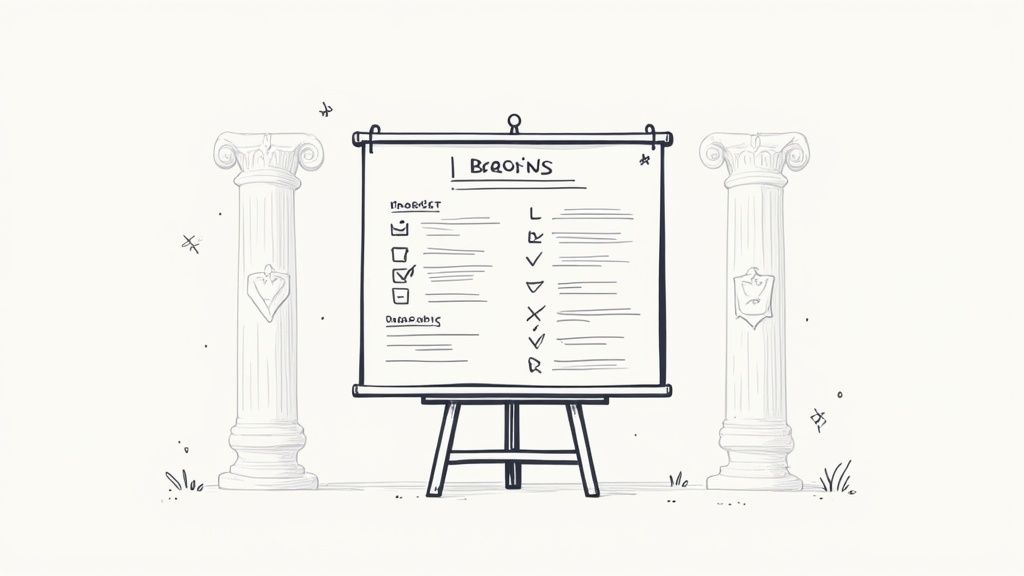The Content Pillar Approach: What Actually Works

A content pillar strategy isn't about churning out volumes of content. It's about building a structured, interconnected ecosystem that positions your brand as the ultimate resource. Instead of isolated blog posts, think of interconnected clusters of content, all orbiting a central pillar topic. This approach aligns perfectly with how people search: starting broad, then diving deep.
Building Topical Authority and User Experience
The power of a content pillar strategy lies in its ability to build topical authority. By covering a subject comprehensively, you showcase your expertise to both your audience and search engines like Google. You become the go-to guide, answering every question your audience might have.
This interconnected structure also elevates the user experience. Instead of navigating a maze of unrelated articles, visitors seamlessly flow through your content, finding precisely what they need at every step.
For example, consider a pillar on "Personal Branding." The core pillar page provides a high-level overview of personal branding principles. Supporting cluster content then delves into specifics: crafting a compelling brand story, defining your target audience, and strategically using social media platforms. This organized structure guides users from basic concepts to advanced techniques.
Why Content Ecosystems Matter
This structured approach boosts user engagement. When visitors find valuable, interconnected content, they stay longer, explore more, and are more likely to convert into loyal customers or followers. In the world of digital marketing, a content pillar strategy is a cornerstone for organizing and optimizing content. Research shows that 82% of companies globally use content marketing as a core strategy, emphasizing the widespread adoption of structured content approaches like pillar-based frameworks. This demonstrates the value businesses place on well-structured content.
Industry Applications and Successes
Content pillar strategies deliver results across various industries. B2B companies use them to establish thought leadership and generate leads. B2C brands leverage them to educate consumers and drive sales. This adaptability comes from addressing a target audience's comprehensive informational needs within a specific niche.
From SaaS companies explaining intricate software features to e-commerce brands showcasing product use cases, the pillar approach offers a scalable framework for content success. The key is tailoring the content format and depth to your specific industry and target audience.
From Structure to Strategy
A content pillar strategy is more than just structure; it's a strategic shift in content creation. It requires thoughtful planning, audience research, and a deep understanding of your target market's needs. The potential rewards – increased visibility, improved user experience, and stronger brand authority – make it a vital investment for any business seeking long-term content success.
Crafting Your First Content Pillar: A Practical Roadmap

Building a content pillar can feel like a monumental task. But with the right roadmap, the process becomes not only manageable, but truly empowering. This section provides a clear, step-by-step guide to crafting your first content pillar, focusing on key elements like audience research, auditing existing content, and implementing actionable frameworks.
Identifying Your Core Pillar Topic
The foundation of any successful content pillar is the right topic. This core subject should be broad enough to cover a range of related subtopics, yet focused enough to maintain relevance and establish your authority.
For example, if you're a fitness coach, "Weight Loss" might be too broad. Conversely, "Optimizing Your Kettlebell Swing" might be too niche. A topic like "Effective Home Workouts for Busy Professionals" strikes a more strategic balance. This approach allows you to reach a wider audience while showcasing your expertise. It also provides ample opportunities to create supporting cluster content.
Audience Research: Uncovering Content Gaps
Truly understanding your audience’s needs and pain points is essential. Effective audience research uncovers those hidden content gaps that your competitors may have missed.
This research might involve surveys, social media polls, and analyzing competitor content. By tapping into what your audience is actively searching for, you can create content that truly resonates and positions you as a valuable resource. Analyzing online forums and Q&A sites, for instance, can reveal recurring questions and unmet needs within your specific niche.
Auditing Existing Content: Repurposing and Expanding
Before diving into creating brand new content, take the time to audit your existing assets. Look at your blog posts, articles, and other resources. Identify pieces that align with your chosen pillar topic. These can be repurposed and expanded to create the supporting cluster content for your pillar.
This not only saves valuable time and resources, but it also strengthens the overall coherence of your content strategy. By connecting existing information with new insights, you create a comprehensive resource hub. This adds significant value to your audience while boosting SEO performance through internal linking.
A Practical Content Pillar Planning Framework
To streamline the process, a structured framework is invaluable. The table below offers a practical guide for developing your content pillar, outlining the key phases, activities, outcomes, and resources involved.
The following table, "Content Pillar Planning Framework," provides a structured approach to planning and executing your content pillar strategy.
| Planning Phase | Key Activities | Expected Outcomes | Resources Needed |
|---|---|---|---|
| Topic Selection | Keyword research, Competitor analysis, Audience surveys | Identification of a relevant and engaging core topic | SEMrush for keyword research, Competitor websites, SurveyMonkey |
| Content Audit | Inventory existing content, Identify relevant pieces, Categorize by subtopic | Mapping of existing resources to pillar structure | Content management system, Google Sheets |
| Content Creation | Develop pillar page, Create cluster content, Establish internal linking | Comprehensive content ecosystem covering core topic and related subtopics | Grammarly for content creation, Yoast SEO |
| Promotion & Distribution | Share across social media, Email marketing, Community engagement | Increased visibility, Audience growth, Lead generation | Hootsuite for social media, Email marketing platform |
| Performance Analysis | Track key metrics, Identify areas for improvement, Refine content strategy | Data-driven optimization for continuous improvement | Google Analytics, Reporting tools |
This framework provides a roadmap for a successful content pillar strategy. By following these steps, you can ensure a cohesive and results-driven approach.
Building a Cohesive Content Ecosystem
By strategically selecting your core topic, diligently researching your audience, and thoughtfully auditing your existing content, you create a powerful foundation for a truly effective content pillar. This structured approach ensures that your content is not only comprehensive, but also precisely targeted to meet the needs of your audience. This focused strategy establishes your authority, enhances the user experience, and ultimately, drives measurable results – setting the stage for long-term content marketing success.
Optimizing Pillars That Actually Rank

Optimizing your content pillar strategy is more than just ticking off SEO boxes. It's about truly grasping what search engines look for and structuring your content accordingly. This means prioritizing key elements like technical SEO, robust internal linking, and strategic keyword research. The goal? A thriving content ecosystem that ranks for hundreds of valuable search terms.
Technical SEO for Pillar Pages
Search engines favor websites built on strong technical foundations. This includes fast loading speeds, mobile responsiveness, and a well-defined site architecture. For pillar pages, these factors are paramount. A sluggish pillar page can deter users and hurt your search rankings. An unresponsive page excludes a large portion of your mobile audience. Prioritize speed and mobile optimization for a seamless user experience.
Structured data markup, using schema markup for example, also gives search engines valuable context. This helps them understand the topics covered in your pillar page and related cluster content, leading to more accurate categorization and improved visibility in search results.
Internal Linking: Distributing Authority Effectively
Internal linking is the lifeblood of any successful content pillar strategy. It connects your pillar page to its supporting cluster content, distributing authority and guiding users. Ineffective linking, however, can confuse both readers and search engines.
Focus on descriptive anchor text that clearly reflects the linked content. Steer clear of generic phrases like "click here." Use keywords related to the target page instead. This improves SEO and enhances the user experience by creating clear navigation. Think of internal links as helpful signposts, guiding readers to relevant information.
Keyword Research for Content Pillars
Keyword research for pillar content requires a more nuanced approach. Identify keywords that align with different stages of buyer awareness. Some users seek broad information, while others are looking for specific solutions.
Begin by identifying broad keywords related to your core topic. Then, dig deeper to uncover long-tail keywords that address particular questions or needs. This allows you to create cluster content tailored to different audience segments. For instance, if your pillar topic is "Personal Branding," a broad keyword might be "build a personal brand." Long-tail keywords could include "personal branding tips for introverts" or "how to use LinkedIn for personal branding."
This focused approach boosts your chances of ranking for relevant keywords. It also provides valuable content that meets the diverse needs of your audience. Tracking content performance with tools like Google Analytics further refines this process. It helps optimize existing content and pinpoint areas for improvement. Measuring the impact of your content pillar strategy is crucial for ongoing success. Businesses using this approach often see substantial SEO gains, as organized content clusters build authority and improve search visibility. Learn more about pillar content strategies here.
Balancing Comprehensive Coverage and Focused Relevance
The best pillar pages strike a balance between comprehensive coverage and focused relevance. They offer a thorough overview without overwhelming the reader. This requires careful planning and a deep understanding of your audience's needs.
A practical approach is to divide your pillar page into logical sections, each addressing a key aspect of the topic. This improves readability and provides clear entry points for users seeking specific information. Imagine your pillar page as a well-organized library, each section a different shelf. This structure empowers users to quickly find what they need. By optimizing both cornerstone content and supporting cluster pieces, you create a cohesive ecosystem that ranks for hundreds of valuable terms, driving targeted traffic and solidifying your expertise.
Aligning Pillars With Your Buyer's Journey

A truly effective content pillar strategy doesn't just organize information; it empowers potential customers on their unique buying journey. Think of it as a roadmap, guiding them step-by-step from initial discovery to a confident purchase decision. This focused approach transforms your content pillars from static resources into dynamic engines of growth.
Understanding the Buyer's Journey and Content Needs
The buyer's journey typically unfolds in distinct stages: awareness, consideration, decision, and action. At each juncture, your customer's needs evolve, and the information they seek changes accordingly. Aligning your content to these specific needs is paramount.
For example, in the awareness stage, a prospect might be researching a problem they're facing. Content that clearly defines the problem and explores potential solutions will resonate deeply. As they transition to the consideration stage, they begin evaluating specific options. Case studies, comparisons, and detailed product information become invaluable resources. Finally, in the decision stage, they're poised to make a purchase. Testimonials, pricing details, and clear calls to action can help solidify their choice.
Adapting Content Formats and Depth
The format and depth of your content should also mirror the buyer's journey. In the awareness stage, concise blog posts or engaging social media updates can effectively introduce the topic. As prospects progress to the consideration and decision stages, more comprehensive content, like ebooks, webinars, or in-depth product guides, becomes essential. This strategic approach delivers the right level of detail at the perfect moment, maximizing its impact.
Consider a pillar on "Personal Branding." An awareness-stage blog post might explore "5 Signs You Need a Stronger Personal Brand." During the consideration phase, a downloadable guide on "Crafting Your Unique Brand Story" could offer deeper insights. Finally, in the decision stage, a case study showcasing a client's successful personal branding transformation would be incredibly persuasive.
Let’s take a look at how to map different content types across the marketing funnel to effectively support each stage of your customer’s journey:
To illustrate this concept, let's consider a practical example. Below is a table demonstrating how different content types within your pillar strategy can support each stage of the customer journey:
Content Pillar Mapping Across Marketing Funnel: How different content types within your pillar strategy support each stage of the customer journey.
| Funnel Stage | Content Objectives | Recommended Formats | Pillar Integration Approach | Success Metrics |
|---|---|---|---|---|
| Awareness | Introduce problem, generate interest, build brand awareness | Blog posts, social media updates, infographics, short videos | Surface level introduction to pillar topics, link to deeper content | Website traffic, social media engagement, brand mentions |
| Consideration | Educate prospects on solutions, position your offering, build trust | Ebooks, white papers, webinars, case studies, comparison guides | Dive deeper into pillar topics, offer valuable insights, showcase expertise | Lead generation, email sign-ups, content downloads |
| Decision | Overcome objections, demonstrate value, encourage conversions | Testimonials, product demos, free trials, pricing information, consultations | Provide compelling evidence and clear calls to action, address specific concerns | Sales conversions, customer acquisition cost, customer lifetime value |
| Action | Onboarding materials, customer support resources, loyalty programs | Email sequences, knowledge base articles, community forums, exclusive content | Nurture customer relationships, provide ongoing value, encourage advocacy | Customer retention rate, customer satisfaction scores, referrals |
This table provides a framework for aligning your content with the buyer's journey, but remember to adapt it based on your specific target audience and industry.
Repurposing and Distributing Content Across Channels
Effective content pillar strategies also leverage the power of repurposing. A core pillar piece can be broken down into smaller, digestible components, such as social media posts, email newsletter excerpts, or infographic snippets. This amplifies your reach and reinforces your core message across multiple touchpoints.
Distributing your content across various platforms is equally crucial. Social media can be incredibly effective for reaching a broad audience during the awareness stage. Email marketing allows for more personalized communication during the consideration and decision phases. By strategically leveraging different channels, you maximize the impact of your carefully crafted content.
Measuring Pillar Performance Throughout the Funnel
Finally, consistently measure the effectiveness of your content at each stage of the journey. Track key metrics like website traffic, social media engagement, email open rates, and conversion rates. This data provides valuable insights for refining your content strategy, ensuring it continues to guide prospects seamlessly through their buying journey. For instance, if a piece of consideration-stage content isn't generating leads, analyze why and adjust your approach accordingly.
By understanding the nuances of the buyer’s journey, you can create highly effective content pillars. These pillars not only educate and engage but also drive conversions by delivering the right information at precisely the right time. This strategic alignment transforms content pillars into invaluable assets for sustainable business growth.
Taking Your Pillars Social: Platform-Specific Strategies
A robust content pillar strategy goes beyond your website and into the dynamic world of social media. This isn't about reposting blog links; it's about strategically tailoring your pillar content to connect with each platform's unique audience and format. This section explores how to transform comprehensive pillar content into engaging social snippets that drive traffic and elevate your brand.
Adapting Your Pillars to Different Social Platforms
Each social media platform has its own distinct culture and style. What works on LinkedIn may not resonate on Instagram. Understanding these nuances is key to effectively sharing your content pillars across channels.
-
LinkedIn: This platform thrives on professional content. Share key insights from your pillars related to industry trends, career development, or thought leadership. Craft short, impactful summaries with a clear call to action, linking back to the full pillar content.
-
Instagram: This visually-driven platform needs engaging imagery and concise captions. Transform data from your pillars into compelling infographics, or offer behind-the-scenes looks at your content creation process. Use relevant hashtags to broaden your reach.
-
Facebook: This platform allows for a mix of formats, from text updates to videos. Use Facebook to host live Q&A sessions related to your pillar topics, or create short video summaries of key takeaways. Encourage interaction with polls and comments.
-
X (formerly Twitter): This platform demands brevity and wit. Share quick, insightful snippets from your pillars, asking questions to spark discussion. Use relevant hashtags to join current conversations and increase visibility.
Creating Platform-Native Content
Transforming your in-depth pillar content into bite-sized social media posts requires a strategic approach. Don't just copy and paste; reimagine your content for each platform.
-
Turn key statistics into visually appealing graphics: A striking image with a powerful statistic can capture attention.
-
Repurpose blog post sections into short video clips: Create engaging video summaries of key points or offer quick tips related to your pillar topic. For example, check out this video: Video Title.
-
Host live Q&A sessions to connect directly with your audience: This fosters interaction and builds stronger relationships with your followers.
-
Run polls and quizzes to gather feedback and spark conversation: This is a great way to gain valuable insights and boost engagement.
Consider the consumption habits of each platform. Short, impactful content does well on fast-paced platforms like X and Instagram. Longer, more detailed content is suitable for platforms like Facebook and LinkedIn, where users often look for deeper information. Content pillars are vital for social media success. As SocialInsider’s 2024 analysis shows, clearly defined content pillars help brands maintain relevance and a cohesive narrative across channels. This is essential for grabbing attention in a competitive marketplace. See this insightful infographic for more information:
Scheduling and Distribution Strategies
Consistency is crucial on social media, but overwhelming your audience can be counterproductive. Create a balanced content calendar that distributes your pillar-related posts strategically. Use social media scheduling tools to automate this process and ensure a steady flow of engaging content.
Measuring Social Media Performance
Track key metrics like engagement, reach, and website clicks to understand what's working. Don't focus only on vanity metrics like follower count. Analyze the data to see what resonates with your audience and refine your strategy accordingly. This data-driven approach will help you optimize your social media presence and maximize the impact of your content pillar strategy. By adapting your pillar content to each platform, creating platform-native formats, and scheduling strategically, you can turn social media into a powerful engine for driving traffic, generating leads, and building a strong brand.
Measuring What Matters: Pillar Performance Metrics
Stop chasing those elusive vanity metrics. Instead, focus on the true impact of your content pillar strategy. This means going beyond superficial likes and shares and diving deep into the Key Performance Indicators (KPIs) that truly reflect effectiveness: visibility, engagement, conversion, and revenue attribution. Let's explore how to implement tracking systems that reveal user navigation patterns and identify the pathways to meaningful business outcomes.
Key Performance Indicators (KPIs) for Content Pillars
The right KPIs provide a clear picture of your content's performance. For a content pillar strategy, these KPIs are particularly vital:
-
Pillar Page Traffic: This metric shows how effectively your pillar page attracts visitors. Use tools like Google Analytics to track page views and unique visitors.
-
Time on Page: A longer time on page often suggests users are engrossed in your content, finding it valuable and informative.
-
Bounce Rate: A high bounce rate may indicate that your content isn't resonating with user expectations or there are usability issues on your page.
-
Cluster Content Performance: Analyze traffic, engagement, and conversions for each piece of cluster content. This pinpoints high-performing topics and reveals areas for improvement.
-
Internal Link Clicks: Tracking clicks on internal links illuminates how users navigate your pillar ecosystem, highlighting areas for optimization.
-
Lead Generation: If your goal is lead generation, measure how many leads originate from your pillar content. Track form submissions, email sign-ups, and other relevant conversions.
-
Sales Conversions: For e-commerce or businesses with direct online sales, track how your pillar content influences purchasing decisions. See the tangible impact of your content strategy.
-
Revenue Attribution: Attribute revenue generated through your content pillar strategy. This might involve using analytics platforms or CRM systems to track customer journeys.
Implementing Tracking Systems
To gather this valuable data, implement comprehensive tracking systems. Google Analytics is a powerful tool for monitoring website traffic and user behavior. Utilize UTM parameters to track traffic sources and understand which channels are driving the most valuable visitors.
For example, when promoting your pillar content on social media, use UTM parameters to distinguish traffic from each platform. This helps pinpoint which social channels are most effective for your content pillar strategy. Integrating your analytics platform with your CRM system provides a holistic view of the customer journey, allowing you to track how content influences conversions and revenue.
Identifying Underperforming Content and Optimizing for Success
Performance data illuminates areas for improvement within your pillar strategy. If a specific cluster piece underperforms, analyze why. Is the topic not resonating with your target audience? Does the content format need adjustment? Data-driven insights empower you to optimize your content for better results.
For example, a blog post with a high bounce rate might benefit from a more engaging introduction or the addition of visuals to break up the text. If a cluster content piece generates significant traffic but low conversions, examine your call to action. Is it clear and aligned with user intent?
Ongoing Content Audits and Adapting to Market Changes
Content pillars are not static; they require ongoing nurturing. Regular content audits ensure your pillars remain relevant and engaging. Analyze user behavior, keep an eye on emerging trends, and assess the performance of your existing content. Based on these insights, refresh outdated content, expand into new topic areas, or consolidate underperforming pieces.
This dynamic approach ensures your content pillar strategy remains a valuable asset, driving consistent traffic, engaging your audience, and supporting your long-term business goals. By focusing on the metrics that truly matter and continuously optimizing based on performance data, you create a thriving content ecosystem.
Real-World Success: Content Pillar Transformation Stories
This section explores how businesses, both B2B and B2C, have used the content pillar strategy to achieve remarkable results. These case studies offer practical insights and demonstrate how this approach can elevate your content marketing efforts.
Case Study 1: B2B SaaS Company – Boosting Lead Generation
A SaaS company specializing in project management software decided to implement a content pillar strategy. They chose "Agile Project Management" as their core topic. Their main pillar page provided a comprehensive overview of Agile methodologies. Supporting cluster content explored specific aspects like Scrum, Kanban, and sprint planning. Within six months, this focused approach increased website traffic by 40% and boosted lead generation by 25%. The key takeaway? Focus on topics relevant to your audience's needs.
Case Study 2: B2C E-commerce Brand – Driving Sales with Educational Content
An e-commerce brand selling organic skincare products built its content pillar around "Natural Skincare Routines." The core pillar page highlighted the benefits of natural ingredients. Supporting content delved into specific skincare concerns like acne, dryness, and anti-aging. This educational approach increased website traffic and drove a 15% increase in sales conversions. The key takeaway? Educate your customers and build trust to influence their buying decisions.
Case Study 3: A Solopreneur’s Journey to Brand Authority
Henri, a personal branding coach, structured his content around core pillars like "Personal Branding" and "Finding Your Purpose." He used various formats, including blog posts, videos, and social media updates, to explore different facets of these themes. This helped him establish himself as an authority in his field, resulting in more client inquiries and speaking opportunities. The key takeaway? Connecting with your audience on a deeper level by offering valuable, relevant content builds trust and positions you as a go-to resource.
Key Takeaways and Practical Applications
These examples show how adaptable the content pillar strategy can be. No matter your industry or business model, a focused, structured approach can yield significant results.
-
Identify your core topics: Choose areas of expertise that align with your audience's needs.
-
Create comprehensive pillar pages: These become central hubs for your content.
-
Develop supporting cluster content: Explore different aspects of your core topics.
-
Promote your pillars strategically: Use social media, email marketing, and other channels.
-
Measure your performance: Track key metrics to understand what's working and where to improve.
Ready to transform your content strategy? Discover how Henri Den can help you build a powerful personal brand with clarity, purpose, and strategic content. Visit Henri Den today!




